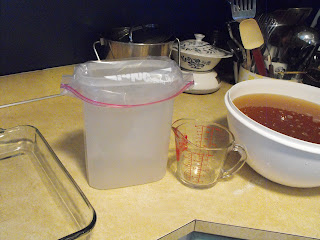Sally Fallon says of meat stock in her book Nourishing Traditions, "Properly prepared, meat stocks are extremely nutritious, containing the minerals of the bone, cartilage, marrow and vegetables as electrolytes, a form that is easy to assimilate. Acidic wine or vinegar added during cooking helps to draw minerals, particularly calcium, magnesium and potassium, into the broth."
 |
This is the beginning of Lamb Stock. I don't usually measure, I just put the rinsed bones, organic carrots, celery, onions, garlic, a handful of peppercorns, a big pinch of seasalt, and about 1 cup of apple cider vinegar into the pot and add filtered water.
I let it simmer all day. And I mean ALL DAY. It takes about 18 hours to get it to boil down into a thick, gelatinous broth.

After it has simmered down, let it set in a cold place to allow the fat to rise and solidfy on the top. Some people like to keep the fat in their broth, if so, you can skip this step. We like our's with as little fat as possible.

Pour the broth into a BIG colander into a BIGGER bowl.
Here, you can see the cooked-down bones and veggies. It looks nasty, I know.
I use a tall tupperware-like container to hold the ziploc freezer bag in place while I pour the broth.
I use gallon-size bags and portion out 4 cups per bag. I've found they freeze and store better when the bags can lay flat.
Pull out the bag and gently squeeze out as much air as possible.
Lay flat in a casserole dish with the zipper part upright (even though it's sealed, it sometimes has a way of leaking).
Here are the bags of stock ready to be placed in the freezer. Once frozen solid, I'll remove them from the dish and stack them freely in the freezer.
Here is a favorite recipe using home-prepared stock:
Minestrone Soup
2 quarts stock
1 clove garlic
1 onion, chopped
2 stalks celery, chopped
2 carrots, peeled and chopped
2 tomatoes, peeled and chopped
2 cups cooked kidney beans
1 cup brown rice pasta, broken into bits
1 cup fresh spinach or swiss chard, finely chopped
Salt and pepper to taste
Parmesan cheese
Saute garlic, onion, celery, and carrot until tender. Add stock, tomatoes, beans, and pasta. Bring to a simmer and then add fresh spinach or chard. Simmer another 10 minutes. Season to taste and garnish with parmesan cheese. Enjoy!







Yummy!!! I never even thought about keeping the skulls. How do you go about selling them? what is the hydrogen mixture that you use?
ReplyDeleteAmazing pictures. You did a fantastic job Joni! I can just about taste it!
ReplyDeleteWe just got the hydrogen peroxide you get at the drug store (I think it's 3%). You can get stronger solution from beauty supply places, but you have to be very careful or it will take your hand off. After skinning the skull you have to take out everything from the inside- this means someone has to take out the brains and eyeballs. I leave this task to our 14 year old son....outside...faraway from the house....while I stay inside....trying not to envision it! Then, place the skull in a bucket and pour enough hydrogen peroxide to cover it. It usually takes several bottles, thankfully it's cheap (less than $1 per bottle). Let it sit in the solution for 24 hours, then dump out the peroxide and pour NEW peroxide to cover it again and wait another 24 hours. Usually, that is sufficient to white the skulls.
ReplyDelete